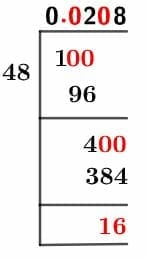What Is 1/48 as a Decimal + Solution With Free Steps
The fraction 1/48 as a decimal is equal to 0.0208.
The division is one of the four basic arithmetic operators. The division between two numbers is often represented by fractions. The solution of such fractions can either be a decimal or an integer.
Here, we are more interested in the division types that result in a Decimal value, as this can be expressed as a Fraction. We see fractions as a way of showing two numbers having the operation of Division between them that result in a value that lies between two Integers.
Now, we introduce the method used to solve said fraction to decimal conversion, called Long Division, which we will discuss in detail moving forward. So, let’s go through the Solution of fraction 1/48.
Solution
First, we convert the fraction components, i.e., the numerator and the denominator, and transform them into the division constituents, i.e., the Dividend and the Divisor, respectively.
This can be done as follows:
Dividend = 1
Divisor = 48
Now, we introduce the most important quantity in our division process: the Quotient. The value represents the Solution to our division and can be expressed as having the following relationship with the Division constituents:
Quotient = Dividend $\div$ Divisor = 1 $\div$ 48
This is when we go through the Long Division solution to our problem. Figure 1 shows the solution for the fraction 1/48.

Figure 1
1/48 Long Division Method
We start solving a problem using the Long Division Method by first taking apart the division’s components and comparing them. As we have 1 and 48, we can see how 1 is Smaller than 48, and to solve this division, we require that 1 be Bigger than 48.
This is done by multiplying the dividend by 10 and checking whether it is bigger than the divisor or not. If so, we calculate the Multiple of the divisor closest to the dividend and subtract it from the Dividend. This produces the Remainder, which we then use as the dividend later.
As dividend 1 is smaller than the divisor 48 we multiply it by 10. After multiplying it becomes 10 and still, it is smaller than the denominator, so we again multiply it by 10. This multiplication requires an extra zero in the quotient.
Now, we begin solving for our dividend which is 100.
We take this 100 and divide it by 48; this can be done as follows:
100 $\div$ 48 $\approx$ 2
Where:
48 x 2 = 96
This will lead to the generation of a Remainder equal to 100 – 96 = 4. Now this means we have to repeat the process by Converting the 4 into 40, but it is still smaller than the divisor which is 48, so it is multiplied by 10 again to make it 400. Also, an extra zero is added to the quotient. Now the new dividend is 400 and solving for that:
400 $\div$ 48 $\approx$ 8
Where:
48 x 8 = 384
Finally, we have a Quotient generated after combining the three pieces of it as 0.0208, with a Remainder equal to 16.
Images/mathematical drawings are created with GeoGebra.
